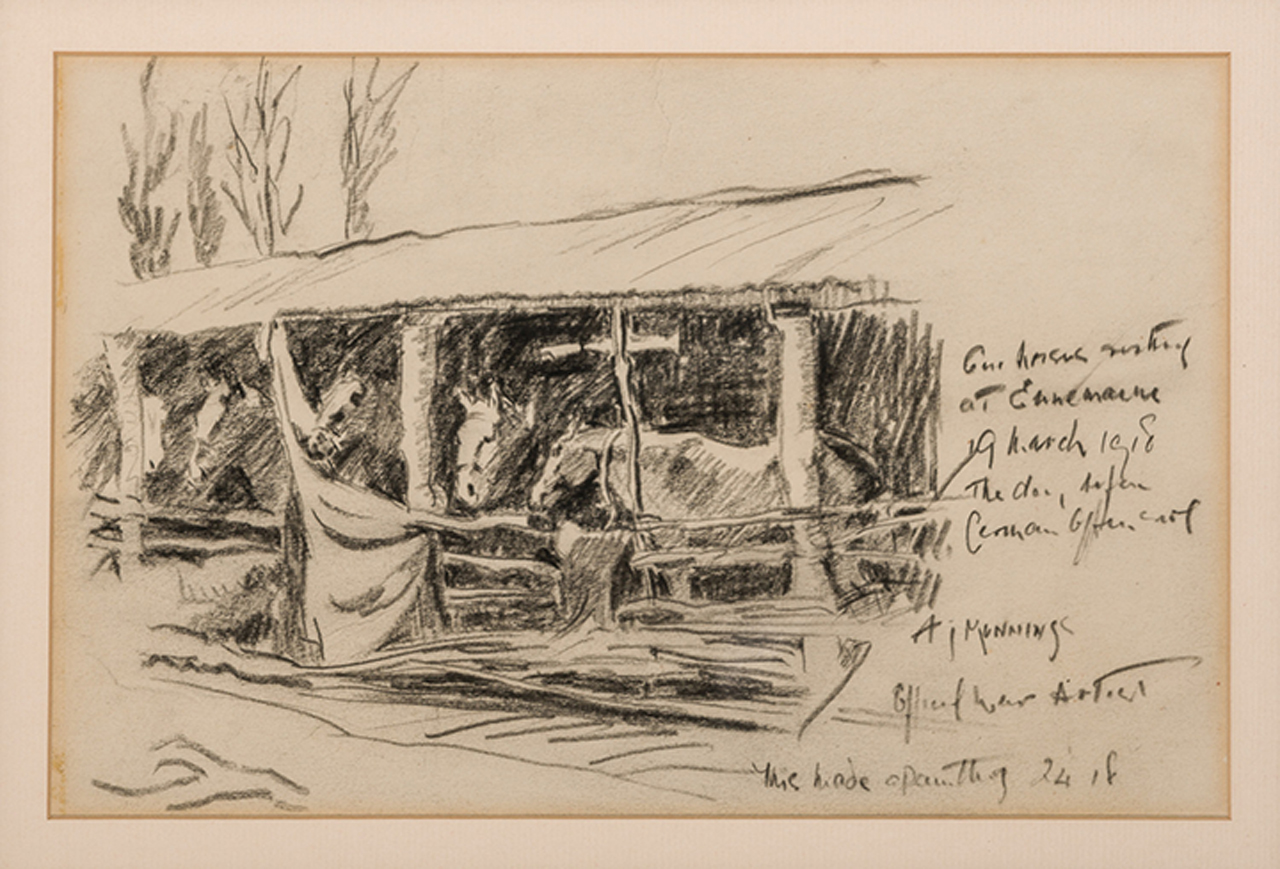2020 Fine Sporting Art, American Paintings, and Sculpture
59| Sir Alfred Munnings (British, 1878-1959)
The Strathcona Horse Lines In France
Signed and inscribedInscribed:Our horses resting at Ennemain / 19 March 1918 / The daybefore German offensive / A.J. Munnings / Official War Artist/ This made a painting 24 18Provenance:Frost and Reed, LondonLord Beaverbrook started the Canadian War Memorials Fundto dispatch artists to document Canadian soldiers during warwhose achievements he thought had been overlooked. AsMunnings noted, he was the official artist to paint the CanadianCavalry Brigade and Canadian Forestry Corps. The CanadianCavalry Brigade comprised several different regiments, one ofwhich was Lord Strathcona’s Horse.Munnings notes on page 306 in volume I of his autobiographyAn Artist’s Life, Taxing my memory, I recall that we arrived ata place called Ennemain, which existed only in mounds andrubble. He goes on to say on page 307, On that particular morning, with the band playing, I was finishing a picture ofthe horses as they stood with their heads out, basking in the sun, between tattered camouflage hanging over roughly-built rows of stabling. I had been patient with each head, with eyes blinking in the sun, and was working on the sixth, which might have been somewhere to the right of the middle of thepicture, when suddenly something was happening – men were running; a sergeant came along, saying: ‘Hurry up, lads! Saddleup and stand to!’ The order went along the lines, and soonthose patient horses were saddled up in full marching order, mounted, and the whole brigade rode away. The present sketch is a study for the finished painting mentioned above and referenced in Munnings’ inscription on the work. The final work can be seen on page 288 of An Artist’s Life andtoday is in the collection of the Canadian War Museum.
Pencil on paper, 6.75" x 10.25"
6000 - 9000
Signed and inscribedInscribed:Our horses resting at Ennemain / 19 March 1918 / The daybefore German offensive / A.J. Munnings / Official War Artist/ This made a painting 24 18Provenance:Frost and Reed, LondonLord Beaverbrook started the Canadian War Memorials Fundto dispatch artists to document Canadian soldiers during warwhose achievements he thought had been overlooked. AsMunnings noted, he was the official artist to paint the CanadianCavalry Brigade and Canadian Forestry Corps. The CanadianCavalry Brigade comprised several different regiments, one ofwhich was Lord Strathcona's Horse.Munnings notes on page 306 in volume I of his autobiographyAn Artist's Life, Taxing my memory, I recall that we arrived ata place called Ennemain, which existed only in mounds andrubble. He goes on to say on page 307, On that particular morning, with the band playing, I was finishing a picture ofthe horses as they stood with their heads out, basking in the sun, between tattered camouflage hanging over roughly-built rows of stabling. I had been patient with each head, with eyes blinking in the sun, and was working on the sixth, which might have been somewhere to the right of the middle of thepicture, when suddenly something was happening - men were running; a sergeant came along, saying: 'Hurry up, lads! Saddleup and stand to!' The order went along the lines, and soonthose patient horses were saddled up in full marching order, mounted, and the whole brigade rode away. The present sketch is a study for the finished painting mentioned above and referenced in Munnings' inscription on the work. The final work can be seen on page 288 of An Artist's Life andtoday is in the collection of the Canadian War Museum.
Signed and inscribedInscribed:Our horses resting at Ennemain / 19 March 1918 / The daybefore German offensive / A.J. Munnings / Official War Artist/ This made a painting 24 18Provenance:Frost and Reed, LondonLord Beaverbrook started the Canadian War Memorials Fundto dispatch artists to document Canadian soldiers during warwhose achievements he thought had been overlooked. AsMunnings noted, he was the official artist to paint the CanadianCavalry Brigade and Canadian Forestry Corps. The CanadianCavalry Brigade comprised several different regiments, one ofwhich was Lord Strathcona's Horse.Munnings notes on page 306 in volume I of his autobiographyAn Artist's Life, Taxing my memory, I recall that we arrived ata place called Ennemain, which existed only in mounds andrubble. He goes on to say on page 307, On that particular morning, with the band playing, I was finishing a picture ofthe horses as they stood with their heads out, basking in the sun, between tattered camouflage hanging over roughly-built rows of stabling. I had been patient with each head, with eyes blinking in the sun, and was working on the sixth, which might have been somewhere to the right of the middle of thepicture, when suddenly something was happening - men were running; a sergeant came along, saying: 'Hurry up, lads! Saddleup and stand to!' The order went along the lines, and soonthose patient horses were saddled up in full marching order, mounted, and the whole brigade rode away. The present sketch is a study for the finished painting mentioned above and referenced in Munnings' inscription on the work. The final work can be seen on page 288 of An Artist's Life andtoday is in the collection of the Canadian War Museum.
To Leave An Absentee Bid, Please Enter An Amount Below


